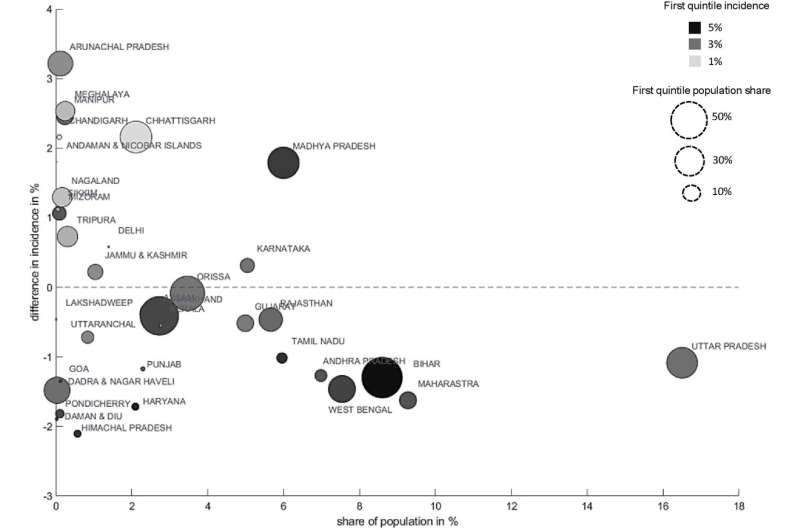This article has been reviewed according to Science X's editorial process and policies. Editors have highlighted the following attributes while ensuring the content's credibility:
fact-checked
peer-reviewed publication
proofread
Calculating the effects of a climate transition in India

India, with its 1.4 billion people, is the third largest greenhouse gas emitter after China and the U.S.. The country is now taking the first steps towards a climate transition with volume targets for the upscaling of renewable energies, a modest turnaround in coal-fired power generation, and plans for carbon pricing in the form of emissions trading.
But the costs and benefits of climate protection are very unevenly distributed across regions, so policy instruments are urgently needed to compensate for this. This is the subject of a study led by the Berlin-based climate research institute MCC (Mercator Research Institute on Global Commons and Climate Change).
The study has now published in the journal Energy Policy. "This huge country with its 29 federal states and seven union territories already has large regional wealth disparities," explains Jose Ordonez, who led the study as part of his doctoral thesis at MCC and is currently working at the EU Commission's Joint Research Centre in Seville.
"We determine the scenario of an ambitious climate transition for the individual geographical units, and examine the combined effect on income distribution, employment and industrial competitiveness. This yields an important finding for central government: without compensatory measures, the gap between poor and wealthy regions threatens to widen significantly."
For its scenario study, the researchers use an input-output model fed with empirical data to map the direct distributional effects of policy measures.
They assume there will be an extensive effort towards climate protection, including a complete coal phase-out, the massive expansion of power generation from solar and wind, a national carbon price of 40 US dollars per ton for private households and companies, and the abolition of energy subsidies. The overall effect of this package on the individual regions, on a qualitative scale from "very disadvantageous" to "very favorable," is key.
The research reveals that the negative effects are heavily concentrated in already poorer states in eastern India that are highly involved in coal-mining, most notably Jharkhand, West Bengal, Odisha, and Bihar. Here jobs would be lost, the burden on poorer households would increase, and energy-intensive industries would come under pressure.
On the other hand, the comparatively richer western Indian states of Mizoram, Delhi, Manipur and Nagaland would be the biggest winners from an ambitious climate policy. The model does not take into account the fact that negatively affected private households and companies can adapt to measures and thus improve their situation. But the researchers point out, among other things, that experience shows short-term effects to be decisive for the enforceability of energy and climate policy measures.
"From the political economic perspective our work provides an important starting point for the further development of climate change in India," says Jan Steckel, head of the MCC working group Climate and Development and one of the co-authors.
"It helps us understand how winners and losers of climate policies are distributed in India. A strong regional concentration of short-term losers can lead to major problems in the political process of implementing climate protection. This has already been shown, for example, in the struggle to phase out coal in Germany."
The researchers emphasize that the climate transition would have to be accompanied by new social and industrial policies in order to make it enforceable in the struggle between competing interest groups, and in order to overcome regional resistance. This can be done, for example, using carbon price revenues, by careful siting of fossil-free energy production, or through compensation payments for the coal phase-out.
It can also provide orientation for a potential Just Energy Transition Partnership with western industrialized countries, i.e., coal phase-out in return for financial aid, following the example of South Africa, Indonesia, and Vietnam.
More information: Jose Antonio Ordonez et al, India's just energy transition: Political economy challenges across states and regions, Energy Policy (2023). DOI: 10.1016/j.enpol.2023.113621
Journal information: Energy Policy
Provided by Mercator Research Institute on Global Commons and Climate Change (MCC) gGmbH




















